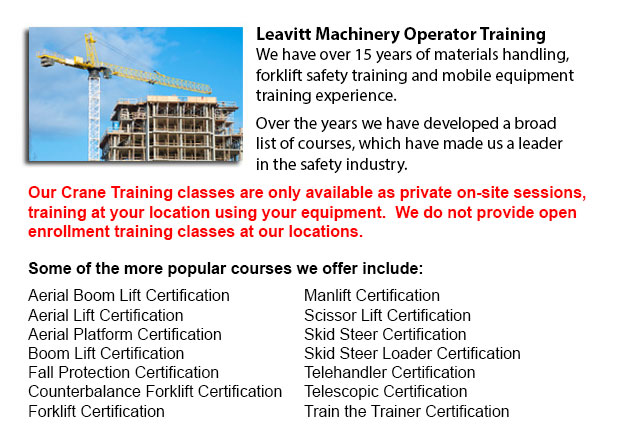
Markham Overhead Crane Operator Training - The course teaching overhead crane operator training has been meant particularly to instruct trainees on the fundamentals of pre-shift inspections and overhead crane/sling operation. The courses are instructed by professional trainers and consultants. Well-trained staff are more efficient and productive, which really saves on expenses connected with merchandise damage, property damage, and accidents because of the utilization of incorrect operating measures. Our overhead crane certification is customized for staff who have literacy barriers, reducing certification time by 50 percent.
The overhead crane has been built to be utilizing performing repetitive hoisting activities. This particular type of crane can be utilized in numerous capacities. They may be used for specialized lifting tasks like installing or removing major plant equipment.
Worker and operators must employ safe rigging practices in order to safely operate an overhead crane. This will need both knowledge and practice because the load needs to be properly rigged to ensure its stability when raised. Prior to starting a lifting job, it must be determined that the crane is suitable for the job, with appropriate capacity, travel and lift. The crane should be subjected to a thorough physical and visual inspection before utilization. The capacity of all machinery, including the hardware, rope and slings, should never go beyond load weight capacities.
The rigger needs to know the right sling for each lift and check slings and other rigging hardware prior to using. Clear signals must be utilized in communications with the crane operator. A signaler has to be designated for the role and signals should be agreed upon. The crane operator needs to follow directions only from the chosen person. If a remote or wired controller is being utilized, the operator must be trained in all its functions.
To be able to guarantee the safety of personnel, a warning needs to be issued and the path of the load should be cleared of all obstacles before the lift begins. People should not be allowed to walk under the lift loads. The crane hoist should be centered over the load prior to hoisting in order to prevent swinging. The safety catch should be closed immediately after sliding the sling entirely onto the lifting hook. Sling legs which are not utilized must be secured so they do not drag. Never leave loose materials on a load being lifted. Watch that fingers and hands are clear when slack is taken out of a sling. Step clear of the danger zone before the lift is made.
-
Markham Forklift Certification Schools
Markham Forklift Certification Schools - Forklift Certification is mandatory in North America. Hence, forklift training programs are essential both for businesses and for people seeking jobs in industries as forklift operators. Forklift training focu... More -
Telehandler Training in Markham
Telescopic handlers normally called telehandlers for short, are a very popular piece of heavy construction equipment. They are commonly utilized in the construction and agricultural trades. These machines have maximum reaching capability and can get... More -
Markham Zoom Boom Training
Markham Zoom Boom Training - Zoom Boom Training is designed to train operators on variable reach forklifts. The objectives of the training are to impart an understanding of the physics of the machinery, and to outline the operator's tasks. This progr... More -
Markham Heavy Equipment Ticket
Markham Heavy Equipment Ticket - A heavy equipment operator will utilize different construction machinery, depending upon the nature of the task at hand. The large equipment are constructed to carry out specific tasks in the most efficient method for... More -
Markham Scissor Lift Training
Markham Scissor Lift Training - When operating a scissor lift, they must be utilized competently so as to protect the safety of the other employees inside the workplace and to protect the safety of the machine. Competent operators are trained to driv... More -
Markham Manlift Operator Training
Markham Manlift Operator Training - The aerial lift or manlift is a specialized kind of hydraulic platform which is designed to raise a person vertically giving it an alternate name of a vertical personnel lift. These machines are widely used for a m... More -
Markham Heavy Equipment Training
Markham Heavy Equipment Training - The two most common kinds of heavy equipment training are classed into the categories of machinery; equipment that is fashioned with tracks and those with rubber tires. The tracked vehicle are heavy duty equipment s... More -
Markham Forklift Safety Training
Markham Forklift Safety Training - Those wanting work in industries that utilize forklifts should undergo a forklift safety training course before becoming a certified operator of a forklift. There are various ways to go about getting forklift safety... More

Forklift Certification Markham
TOLL FREE: 1-888-254-6157
Markham, Ontario
forkliftcertificationmarkham.com
Email Us
About Us


